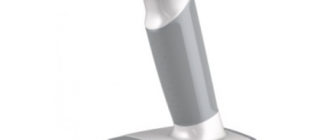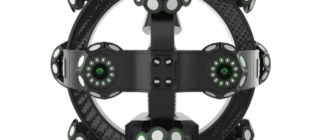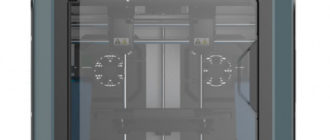Most modern 3D printers with a CNC unit use the same approach to the 3D printing process. The components and individual parts of such devices may differ, but in general, the principles of construction and design of printers are virtually the same.
What does a 3D printer consist of: the main components
The principles of operation of 3D printers are similar to those previously used by Cartesian robots.
A 3D printer is a device whose parts can move linearly in three dimensions at once, using the X, Y and Z axes, called Cartesian coordinates. The movement is provided by small-sized stepper motors, which are highly accurate and precise. Their error is no more than 1.8 degrees per step.
Like all other numerically controlled machines, 3D printers are controlled by a built-in controller. Its presence allows the movement of the device print head, which leads the molten plastic, which is applied to the work surface and provides layer-by-layer printing of the product.
Also, many 3D printers are equipped with timing belts and special rollers located on the X and Y axes. This technical addition makes it possible to move the extruder at high speed while maintaining its precise positioning.
The main parts of all 3D printers are:
- extruder (print head);
- working table;
- a set of moving mechanisms;
- cooling system (fans);
- frame;
- control electronics.
Desktop
The printer’s worktable is the surface on which the molten material from the extruder is applied in layers during printing to form the finished product. Depending on the model of the printing device, the table can vary in size from 100 to 200 square millimeters.
The surface of the worktable is made of glass or aluminum. These materials allow for efficient heat distribution across the work surface, which provides additional alignment of the product.
IMPORTANT: Glass provides a smoother surface, and aluminum tables have greater thermal conductivity.
To ensure that the printed model is securely fixed on the table, the platform surface is often covered with a layer of glue or a special film.
Frame
All components of the 3D printer are fixed on a special frame, which has a high degree of strength and rigidity.
It protects the device components from the adverse effects of external factors and is responsible for the geometric safety of the device, as well as the absence of backlashes and vibrations arising in the printing process.
Frames of 3D-printers can be both open, consisting only of aluminum guides, and closed, where the structure is complemented by organic glass or plywood.

Printhead
The most important part of any FDM 3D printer is the printhead, which consists of two parts – the extruder and the heating element.
The extruder (cold-end) is the mechanism responsible for feeding the material to the heater.
The heater (hot-end) is the part of the printhead responsible for melting and squeezing the plastic filament through the nozzle hole, which can vary in diameter from 0,14 to 0,60 mm.

IMPORTANT: The extruder of a particular model is designed to work with filaments of the same diameter. This parameter should be taken into consideration when purchasing printing materials.
The print head is equipped with a stepper motor with a system of shafts and gears to ensure a continuous supply of material to the extruder. The controller that controls the motor is responsible for the rate of polymer feeding and retrieval during material changes.
When the printer is in active use, the nozzle orifice becomes fouled, which reduces flow and reduces print quality. You can solve the problem by cleaning the part or replacing it with a new one.
Most modern 3D printers have a single print head, but some models have more than one. These printers are designed to print two types of plastic at once.

Components of the movement mechanism
For the movement of the platform and print head on the coordinate axes in the course of printing are responsible movement mechanisms, consisting of motors and several rails, combined into a system.
More often than not, three motors are sufficient for the effective operation of a 3D printer, moving the head along the X and Y axes and the platform moving vertically (Z axis).
To convert the rotational motion of the rotor motors, the system is supplemented by pulleys and toothed belts or threaded shafts, which are responsible for converting the rotation into translational motion.
In budget models of 3D-printers the guides have a cylindrical shape, in more expensive variants manufacturers prefer to use linear guides, which are made of steel. The quality and cleanliness of the guideways directly affect the printing accuracy.
The edge positions of the worktable and printhead are monitored by sensors that are installed in different locations. The most precise sensors are LED sensors, photodiodes and sensors based on magnetic radiation.

Electronics
The work of all the components of the 3D-printer is controlled by the controller, which recognizes the G-code, written by a special program and adjusted by the user.
The program for the controller is created in a special editor in the format of STL-file, which describes the 3D-model. In the code text the sequence and type of movements of the print head and worktable, as well as the need to turn on and off the heating elements or cooling system are encoded with special symbols.
Most controllers are based on the Arduino platform, which has an open architecture. The hardware most often uses Atmel or ATmega2560 microcontrollers.
In order to connect the modules and the microcontroller board efficiently, intermediate boards (RAMPS) are used, which have pins for connection to the microcontroller board and connectors on the back side, into which the necessary modules and external equipment can be connected.
All of the above components form a single compact unit that provides model recognition and is ready to work as part of an FDM-3D-printer.
Some models of 3D-printers can be controlled by personal computers or Wi-Fi network, others – are equipped with their own control panel. Some models of printers are also additionally equipped with memory card reader slots or ports for USB-drives. Their presence allows you to download models into the memory of the device without having to connect the printer to a personal computer.

The importance of properly assembling 3D printer parts
The final quality of the 3D printer depends directly on how accurately and qualitatively the components are assembled. Poor quality assembly leads to backlash, missing motor steps, insufficient or excessive heating and cooling of the elements.
3D-printing is a complex and time-consuming process, the quality of which depends directly on the quality of the device assembly. When buying a 3D printer, you should carefully check the condition of the main components and their adaptation to the specific tasks.







